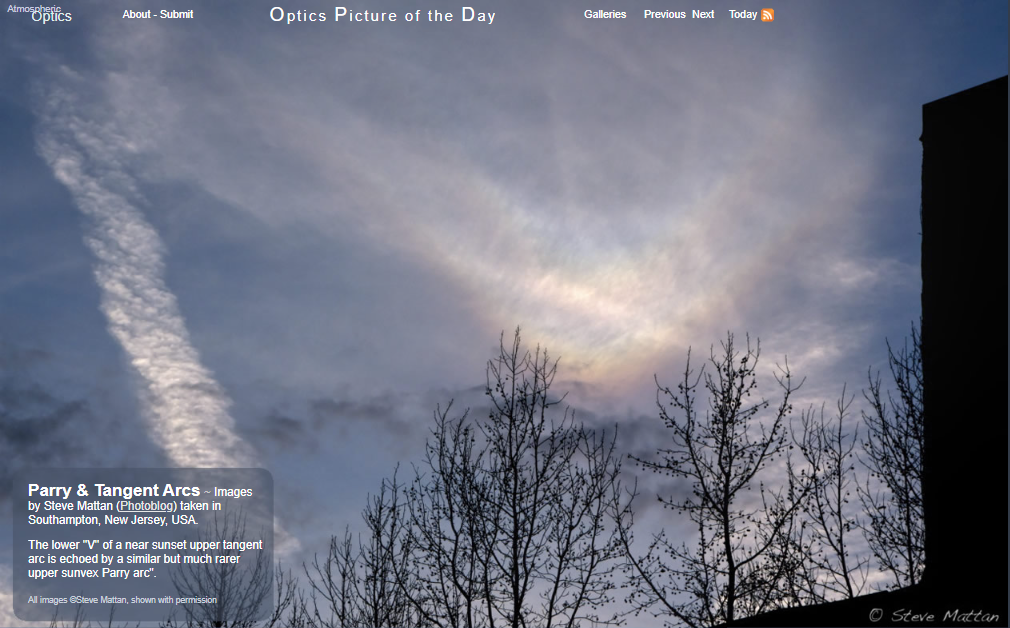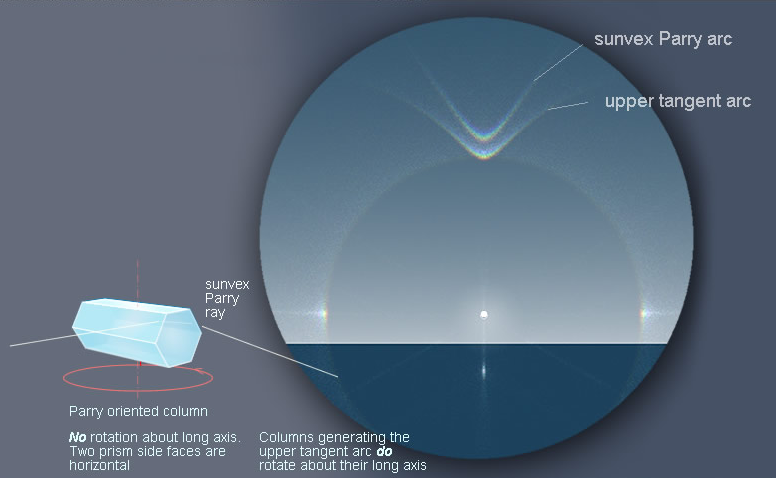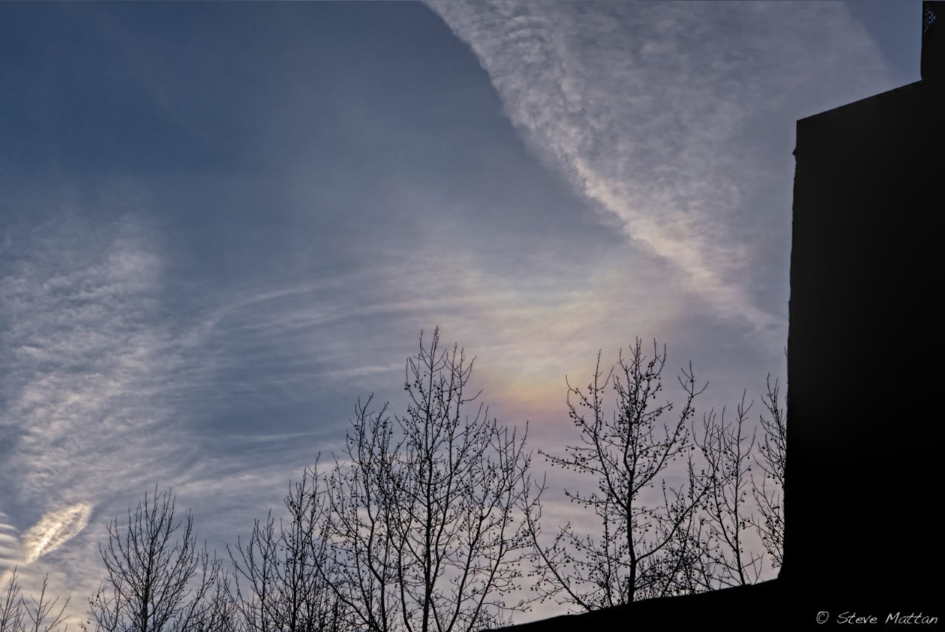Parry & Upper Tangent Arcs - OPOD
Parry & Upper Tangent Arcs - Exploring Rare Atmospheric Optical Phenomena
Have you ever gazed at the sky during a sunset and noticed peculiar arcs of light surrounding the sun? These captivating phenomena are known as Parry and upper tangent arcs. While the lower "V" shape of the near sunset upper tangent arc is a common sight, the upper sunvex Parry arc is a much rarer and extraordinary occurrence. In this article, we will delve into the fascinating world of these atmospheric optics phenomena, unraveling their origins and shedding light on their elusive nature.
The Dance of Changing Shapes and Separation
When the sun is low in the sky and a tangent arc becomes visible, it is always worth the wait to search above it. The diligent observer may be rewarded with the enchanting sight of a Parry arc. These arcs, both the tangent and Parry, exhibit a dynamic interplay of changing shapes and separation as the altitude of the sun fluctuates. Their ephemeral nature adds to their allure, making each sighting a unique experience.
Crystal Prisms and Ray Manipulation
Both Parry and tangent arcs are formed by rays of sunlight passing through specific types of ice crystals. These crystals enter through one side face of a horizontal column crystal and exit through another face inclined at an angle of 60° to the first. This process causes the light to refract and create the distinct arcs in the sky.
The Unique Orientation of Parry Arcs
The key distinction between Parry and tangent arcs lies in the orientation of the ice crystals. Parry-oriented crystals do not assume all possible rotational positions about their long axes like their tangent counterparts. Instead, the upper and lower prism faces of Parry crystals remain fixed horizontally. This peculiar orientation, although not fully understood, gives rise to the distinctive upper sunvex Parry arc.
Unraveling the Mystery
The reason behind the unique orientation of Parry arcs is still a subject of scientific intrigue. Researchers have yet to unravel the exact mechanisms that lead to this phenomenon. However, one thing is clear – Parry arcs are exceptionally rare. They appear in the sky when only a small number of Parry-oriented crystals are present, showcasing the extraordinary efficiency of their generation.
Exploring the World of Atmospheric Optics
The study of atmospheric optics offers a captivating glimpse into the wonders of nature. As we observe and analyze the intricate interplay between sunlight and ice crystals, we uncover a myriad of optical phenomena that can leave us in awe. Parry and upper tangent arcs are just two examples of the enchanting displays that can grace our skies, reminding us of the beauty and complexity of the natural world.
A Visual Feast for the Skygazer
If you find yourself fortunate enough to witness a Parry or upper tangent arc, take a moment to savor the spectacle before you. These ethereal arcs add a touch of magic to our everyday lives, reminding us to look up and appreciate the marvels that surround us. Capture the moment in your memory or through photography, and share the wonder with others.
In conclusion, Parry and upper tangent arcs are captivating atmospheric optical phenomena that grace our skies during certain conditions. Their ever-changing shapes and separation, along with their elusive nature, make each sighting a unique experience. While the exact reasons behind the unique orientation of Parry arcs remain a mystery, their rarity and efficiency in generating these arcs only add to their allure. So, keep your eyes peeled during sunsets and be prepared for a visual feast that transcends the ordinary.

Parry & Tangent Arcs ~ Images by Steve Mattan (Photoblog) taken in Southampton, New Jersey, USA.
The lower "V" of a near sunset upper tangent arc is echoed by a similar but much rarer upper sunvex Parry arc".
All images ©Steve Mattan, shown with permission

Whenever the sun is low and a tangent arc is visible always wait and search above it. You may be rewarded by a Parry arc. The two arcs quickly change shape and separation as the sun altitude changes. Check here for their shapes.
Both arcs are produced by rays entering a side face of a horizontal column crystal and leaving through another inclined 60° to the first.
The only difference is that Parry oriented crystals do not take all rotational positions about their long axes. Instead an upper and lower prism face stays fixed horizontal.
The reason for this orientation is not properly understood. It is rare. We only see Parry arcs because their generation is extraordinarily efficient. Only a whiff of Parry oriented crystals is necessary.

Note: this article has been automatically converted from the old site and may not appear as intended. You can find the original article here.
Reference Atmospheric Optics
If you use any of the definitions, information, or data presented on Atmospheric Optics, please copy the link or reference below to properly credit us as the reference source. Thank you!
-
<a href="https://atoptics.co.uk/blog/parry-upper-tangent-arcs-opod-2/">Parry & Upper Tangent Arcs - OPOD</a>
-
"Parry & Upper Tangent Arcs - OPOD". Atmospheric Optics. Accessed on December 22, 2024. https://atoptics.co.uk/blog/parry-upper-tangent-arcs-opod-2/.
-
"Parry & Upper Tangent Arcs - OPOD". Atmospheric Optics, https://atoptics.co.uk/blog/parry-upper-tangent-arcs-opod-2/. Accessed 22 December, 2024
-
Parry & Upper Tangent Arcs - OPOD. Atmospheric Optics. Retrieved from https://atoptics.co.uk/blog/parry-upper-tangent-arcs-opod-2/.